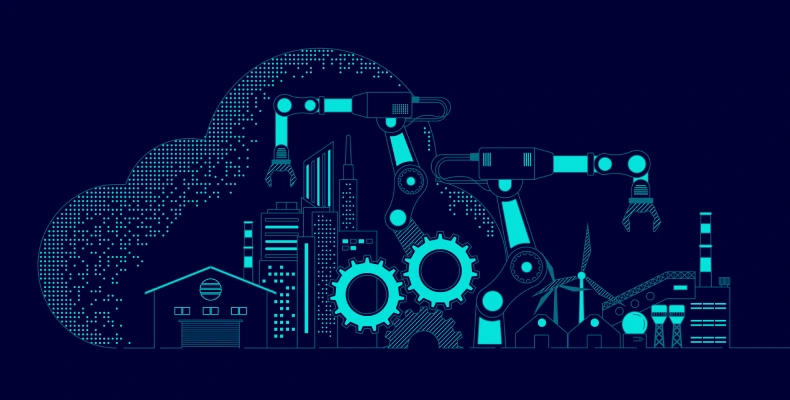We use cookies to ensure we give you the best experience on our website. By clicking Agree you accept our Privacy and Cookies Policy.
Hyperautomation – the future of business processes

Mykhaylo Terentyak
Author

March 3, 2024
Date

 9 minutes read
9 minutes read
Content
What is hyperautomation?
Robotics has always served to perform routine tasks that don’t require much intelligence but high speed and accuracy, which take humans years and years of practice. However, now business processes are increasingly not following stable and predictable scenarios. It created a need for a new type of automation. Hyperautomation (the term coined by Gartner), also known as Intelligent or Digital Process Automation, is a trend on everyone’s lips. The new approach is not restricted to manufacturing only and creates added value across many industries – medicine, retail, insurance, software development, etc. According to Gartner, forward-thinking businesses should think of building a hyper-automation strategy to keep up with the times and stay competitive. So, what is it? In simple words, it is a synergy of technologies and state-of-the-art tools to automate all processes that can be automated. It has robotic process automation (RPA) as its core with a layer of Artificial Intelligence. Therefore, it is also referred to as RPAAI or “unassisted RPA.” The RPA market is predicted to reach $2.9 billion in 2021, whereas companies will spend almost $100 billion on AI by 2023. Accenture provides interesting insights on how humans and machines will interact in the future in the form of collaborative intelligence. The main idea is not to outflank human employees but free them of low-value repetitive tasks and equip them with tools that will considerably improve business outcomes.
Components – RPA, AI, process mining, etc.
RPA emulates human actions when dealing with a system or a device through a UI interface. It is task-specific, works with structured data, and differently from hyper-automation, which requires a whole ecosystem, can be done from a single platform. RPA makes no changes to the legacy systems. It has a wide adoption now and established best practices.
Decision-making and processing unstructured, ambiguous data are what Artificial Intelligence is good at. It helps to automate entire workflows, not just specific tasks. Through certain algorithms, Machine Learning as part of AI ensures constant improvement of processes based on previous experience. ML was invented in the 1950s and has been used for forecasts, fraud detection, to name just a few.
Natural Language Processing (NLP) is AI’s ability to “understand” and respond to human language. A vivid example of this is Siri from Apple.
Optical Character Recognition (OCR) converts any format of text into machine-readable. It automates the process of capturing visual data and interpreting them to perform the required task.
Process Mining is another crucial element. Software systems identify business processes that have efficiency and compliance problems and thus accelerate automation. The result is creating the Digital Twin of an Organization – a virtual clone of a process to test a range of scenarios to find the optimum one and then control if automation runs as expected.
Hyperautomation vs. traditional automation
Automation focuses on using technology to perform repetitive, rule-based tasks with little or no human intervention. It streamlines efficiency but typically operates within a narrow scope, often limited to a single process or department.
Hyperautomation, by contrast, is broader and more intelligent. It layers advanced technologies, such as artificial intelligence (AI), machine learning (ML), robotic process automation (RPA), and process intelligence on top of basic automation to automate not just tasks but entire end-to-end workflows. It also emphasizes adaptability, enabling organizations to optimize processes continuously rather than stopping at a single automation initiative.
In short, while automation saves time in isolated areas, hyperautomation acts as a strategic framework that scales across the enterprise, transforming how businesses operate and innovate.
Hyperautomation vs. RPA
Robotic Process Automation (RPA) is often confused with hyperautomation because it, too, automates repetitive tasks. The difference lies in scope and sophistication. RPA is rule-driven — it follows pre-defined instructions, such as copying data between systems or processing invoices. It delivers efficiency but has limited adaptability.
Hyperautomation builds on RPA by integrating AI, ML, and advanced analytics to handle unstructured data, make decisions, and learn over time. Where RPA might automate a single step in a workflow, hyperautomation connects multiple systems, enabling end-to-end automation with decision-making capabilities.
Simply put, RPA is a tool while hyperautomation is a strategy. RPA handles tasks. Hyperautomation reshapes processes, using RPA as just one component in a larger ecosystem.
Practical applications of hyperautomation
Businesses turn to hyperautomation to improve efficiency, reduce costs, and increase accuracy in mission-critical processes. In finance, for example, it streamlines loan approvals by combining RPA for document handling with AI models for risk assessment. In healthcare, it automates patient intake and medical record updates while ensuring compliance with data regulations. Retailers use it to optimize supply chains, combining demand forecasting with automated order processing. At its core, hyperautomation is used for business-wide process transformation, from customer onboarding and HR management to IT operations and compliance monitoring.
How hyperautomation works in practice
Process intelligence
Hyperautomation begins with visibility. Process intelligence tools use data mining and analytics to map how processes actually work, not just how they’re documented. These insights highlight inefficiencies, bottlenecks, and exceptions that manual observation often misses.
By identifying areas most suitable for automation, organizations avoid wasted effort and focus investments where they will deliver measurable returns. Process intelligence also supports continuous improvement, as it feeds real-time data into AI models that refine workflows over time.
Business Process Management (BPM)
Once opportunities are identified, business process management (BPM) systems provide the framework for execution. BPM platforms integrate automated workflows, RPA bots, AI services, and human tasks into a cohesive ecosystem. They ensure that automation is aligned with business rules, compliance requirements, and organizational goals.
BPM also adds adaptability: as business needs evolve, workflows can be adjusted without rebuilding entire systems. When paired with hyperautomation, BPM transforms from a static workflow tool into a dynamic orchestration layer, managing both people and machines.
Industry impact
Below, you can find several examples of how this approach works in different domains.
Hyperautomation has a wide range of applications in the banking industry, from marketing to payment operations. Prevention of fraud and money laundering is possible with the help of ML-based predictive modeling. Advanced Analytics assesses borrowers and minimizes risks for the bank, and considerably shortens the decision time for the client.
In insurance, there are many manual operations, such as dealing with claims. Intelligent automation allows validating information and ensuring compliance with high accuracy and speed, round the clock. Processing a plethora of scanned and digital documents and selecting the optimum insurance product for clients are just a few tasks that can be streamlined with the digital workforce.
In retail, digitalization encompasses all core operations: handling orders, logistics, supplies, procurement, etc. AI enables dynamic pricing through real-time analysis of competitor websites and other factors, such as user sentiments, e.g., through social media trends.
AI-based chatbots are becoming a convenient alternative to customer support teams. Instead of only providing pre-defined responses to queries, a new generation of chatbots analyzes response satisfaction rates and user behavior on the website to provide more relevant information. The system behind it also automatically generates smart analytics. It also can handle such tasks as locating data and automatic follow-up on leads.
In healthcare, automation works wonders with smart billing, processing insurance, and claims documentation – tasks that take up thousands of valuable manhours. Doctors do not have to spend time filling in electronic health records manually, thanks to ML-based voice-recognition transcribing systems. Sophisticated AI bots can interact with patients at home, analyze symptoms, and direct them to hospitals if necessary.

Benefits of hyperautomation
Let’s sum up the main benefits this technology can create for a company:
- Incomparably (to humans) faster and error-free performance.
- The absence of mundane tasks contributes to employee satisfaction.
- Advanced analytics for better decision-making. AI helps not only to retrieve data from business processes but provides valuable insights and potential action plans.
- End-to-end automation of sophisticated processes and workflows with various datasets.
- Improved customer experience and ultra-personalization.
- Higher profitability by considerably augmenting process efficiency.
- Continuity of improvement thanks to ML.
- Scalability. Smart automation spares time and resources for growth.
A real-world example of hyperautomation
A good example of hyperautomation would be an insurance company processing claims. With traditional automation, RPA bots might collect claim details from emails and enter them into a database. With hyperautomation, AI models classify claim types, ML predicts fraudulent activity, and BPM orchestrates approvals. As a result, the company reseaves a seamless workflow, from intake to resolution, with minimal human involvement and faster turnaround times for customers.
Potential challenges to keep in mind
While impressively helpful, hyperautomation comes with some challenges that need to be considered. The first one is complexity: integrating multiple technologies (RPA, AI, BPM, analytics) requires careful planning and skilled teams. Another concern is cost, as initial investments in tools and infrastructure can be significant.
There are also cultural aspects. Employees may resist change, fearing job loss, while leadership may underestimate the training and governance needed. Security and compliance also add complications, especially when sensitive data is involved. To succeed, organizations must treat hyperautomation as a long-term transformation, not a fast-fix and think strategically.
Conclusion
Although hyper-automation is still in its very early stages of development, it is inevitable in almost all spheres. “Faster, better, safer”- these words have always been the motto for successful businesses all over the world, and now there is another one – “digital.” The Covid-19 pandemic has demonstrated how volatile the world is, and economic conditions, as well as user behavior, can change in the blink of an eye. In this light, intelligent automation seems to be a must, as it offers the key not only to survival but higher ROI thanks to cost-cutting and flexibility. However, its implementation requires meticulous planning, building a viable strategy, and identifying the right tools.
Blackthorn Vision has been in the automation market for more than a decade. We have created business solutions for such industry giants as Sensia. It is what makes us a trustworthy partner for a digital transformation of your business. If you feel the need to streamline your company and do not know where to start, our Discovery Phase will draw a comprehensive automation map for you. Contact us now to get your customized solution.




































































